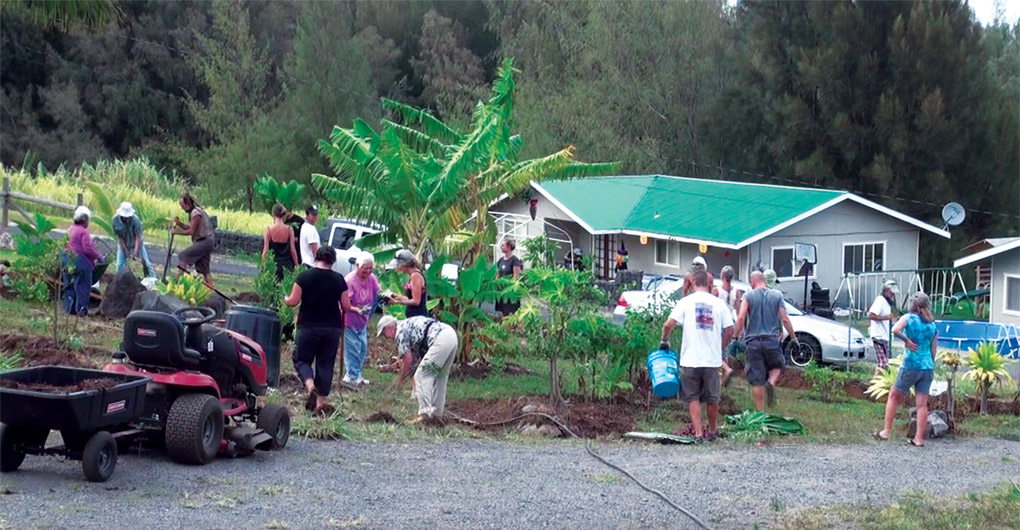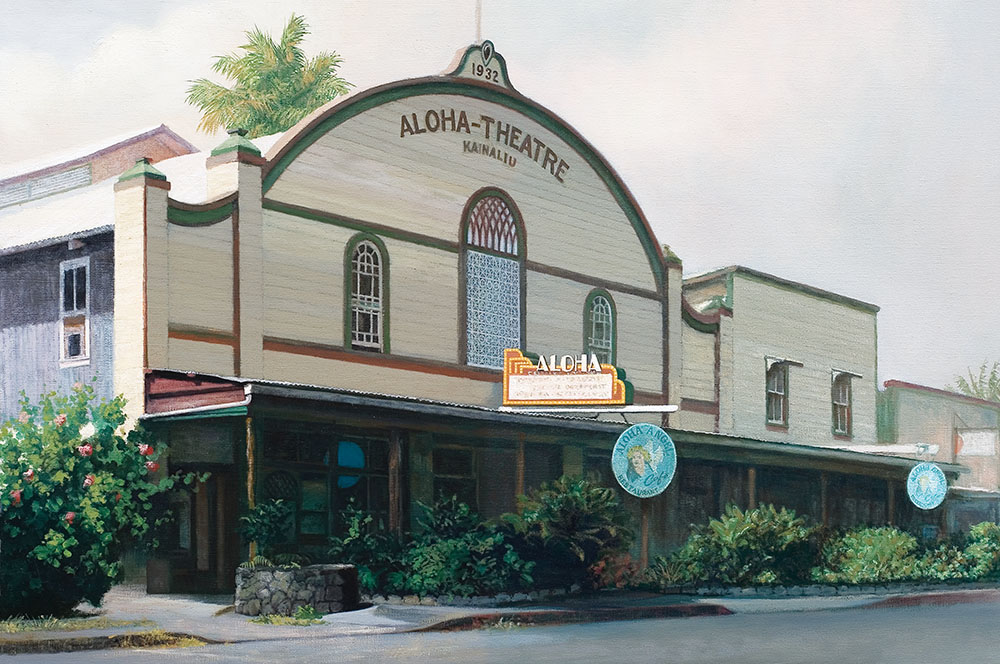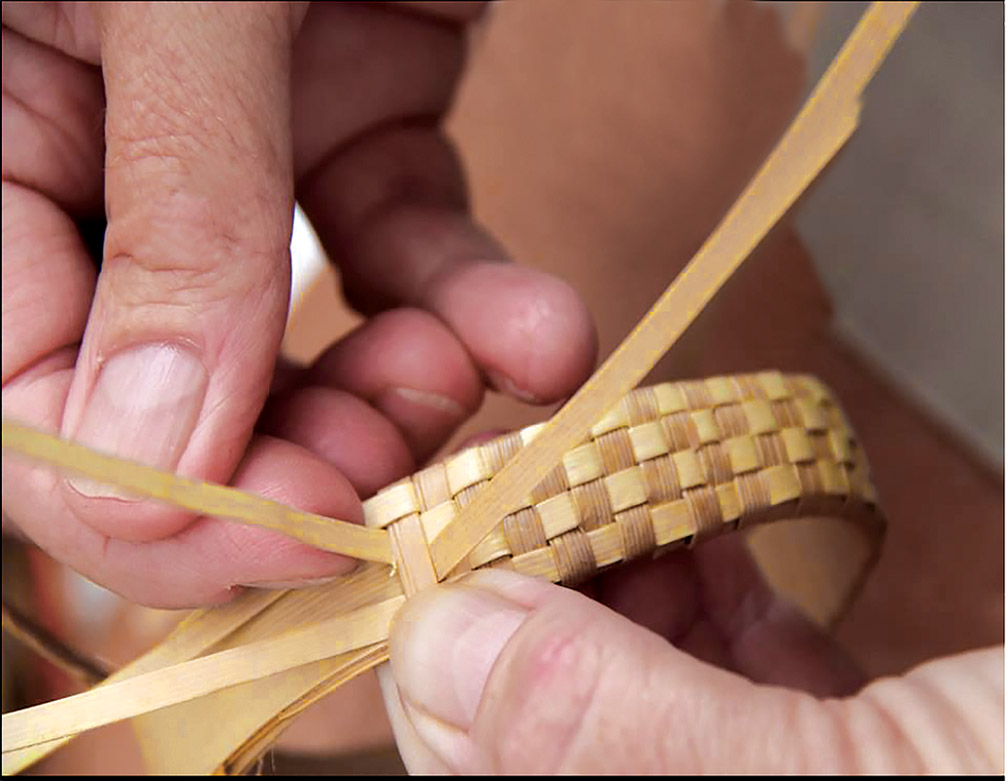
Lauhala Has Strong Roots in Puna: ‘Aha Pūhala O Puna Weaving Club celebrates its 25th anniversary

By Karen Valentine
“Nānā i ke kumu” is a Hawaiian proverb—‘ōlelo no‘eau—commonly used throughout the culture to express the correct way of passing down wisdom from one generation to the next, from teacher to student, and even from the wisdom of nature to those who seek answers. It means “look to the source” or “look to the teacher.”
As with many Hawaiian cultural arts, the art of lauhala weaving is best learned directly from kumu (teacher) to student. In the process, very personal relationships are formed between the two and can last for decades.
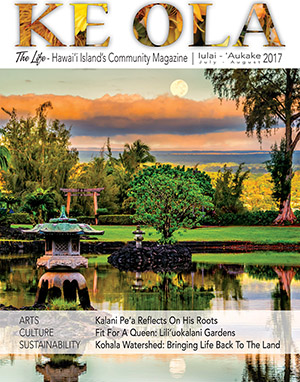
Aunty Lily Sugahara was one such beloved kumu. A master weaver who desired to pass on the art, she and fellow master Aunty Minnie Ka‘awaloa set out to form a local lauhala weaving club in Puna, a land known for its fragrant hala. They called together other interested weavers and formed ‘Aha Pūhala O Puna in 1992.
The club accomplishes its mission “to promote the art and culture of Hawaiian lauhala weaving” through teaching workshops, demonstrations, and a conference held every five years.
In honor and recognition of the founders of ‘Aha Pūhala O Puna, the club members have set the theme of their upcoming fall conference, commemorating the club’s 25th year as “Nānā I Ke Kumu.”
“Especially as many of our kūpuna and kumu lauhala have passed away recently, we find this time essential in encouraging new weavers to learn the art of ulana lauhala,” said club member Valdeane Odachi.
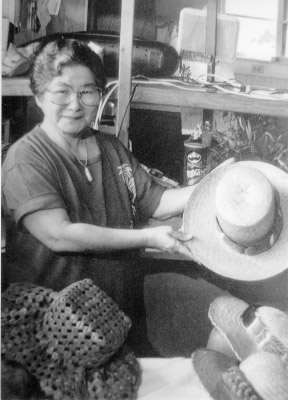
The conference is set for October 12–15, 2017, at the Hilo Hawaiian Hotel.
“We were so lucky to have Aunty Lily as our teacher,” says club president Katie Lowrey. The co-founder kupuna stayed with the club as a kumu for some 20 years, sharing her skill and knowledge. “In 2009, when her health was becoming fragile, she named five of us to carry on. In a special ‘ūniki ceremony, she designated us officially as master lauhala weavers.”
The five include Katie and four others: Kathy Walsh, Pam Lipscomb, Dee Shimabukuro, and Jo Ann Park. They are now teaching the next students, from beginning to advanced, and loving the process. Aunty Lily passed away from cancer in 2010.
“The kūpuna have been so generous, sharing their knowledge with us of all ethnicities,” said Katie. “Our club wants to continue that tradition of sharing with aloha the weaving traditions of Hawai‘i.”
In particular, she says, the members are excited about the upcoming conference.
“Our members love the conference, making lei for the kumu who are coming and early-registration bonus gifts for the first 25 people who sign up.” The gifts are handmade lauhala treasures. “That’s what excites the members. What can we weave?”
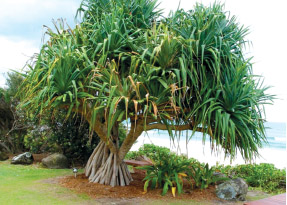
The hala tree (Pandanus), which produces the leaves (lauhala) from which the crafts are made, may be seen somewhat comically as a many-legged creature with an unkempt head of hair. It perches upon strong roots that extend upward from ground level. Its long leaves are strong and tough, providing durable material for a plethora of useful items.
This important tree is most famous in Hawaiian legend in the district of Puna. It is here where it is said Pele burned the sacred hala grove of her sister Hi‘iaka in a fit of jealous rage. Legend also says that the hala tree is so abundant here because upon first landing on the island, Pele’s canoe got entangled in the tough roots and leaves. In her anger she ripped the trees into pieces and threw them across the island, where the hala sprouted far and wide. It was a fortunate propagation—from pollen to blossom to flower to fruit, from leaf to bark to wood to root, all parts of the tree have value. In the old days lauhala was used for canoe sails, wall thatch, window-shutters, roof lining, mats, and even for protective male loincloths. The dried, stiff fruit can be used as paintbrushes. Techniques have hardly changed, a testimony to the exquisite artisanship of the early Hawaiians. Today, contemporary weavers have adapted their craft to a changing market (purses, baskets, bottle holders, and placemats). Especially treasured as examples of master workmanship are pāpale (hats).
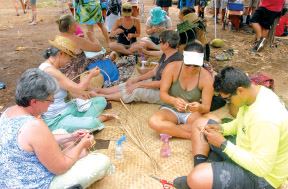
At the workshops, Katie says, everyone comes in saying they want to make a hat. However, it takes several years of making more basic items to even begin the intricate process of weaving and shaping a hat.
“We expect 90 to 100 people including 20 kumu. In four days, they make a lot of things: trivets, bracelets, a lauhala-covered brick doorstop, slipper covers, jewelry, purses, tote bags and beginning twill weave (something you have to know to make a hat),” she says. A few of the well-known kumu lauhala who will be teaching are Pohaku Kaho‘ohanohano from Maui, Margaret Lovett from Kaua‘i, and Lola Spencer from Moloka‘i.
Students in the beginner class are initiated into lauhala weaving through the very first steps of gathering the lau, stripping thorns (ouch!), flattening, rolling, cutting into strips, and plaiting or ulana (the correct term, instead of weaving). That’s the time when they learn and appreciate the art of patience. They also learn various designs and methods of plaiting.
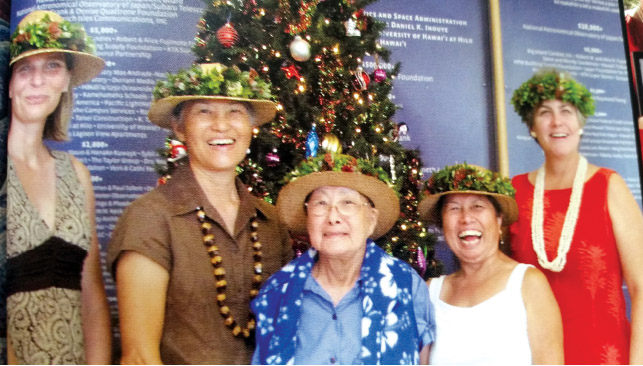
Lauhala connoisseurs know the difference between Hawai‘i-made lauhala and cheaper imports available in retail outlets. The hats and bags that local artisans once made for practical reasons are now recognized as art, and modern practitioners weave out of passion, not for money. Some weave, too, because the slow pace and patience the craft demands recall a simpler, less frenetic past.
A nice hat can cost $1,000, for example, which probably doesn’t even begin to pay a decent hourly rate for the time that went into it. The fine lauhala strips are plaited in intricate patterns. Beautiful lauhala hats are treasured and coveted by connoisseurs, all of whom appreciate and admire a fine hat being worn proudly by someone.
“I like to make hats the most. They’re fun,” says Katie, who has been weaving since 1980. “You can get addicted to it. It’s a tactile thing. I’ve planted maybe 20 trees in my yard.”
There is a banquet on the last night of the fall conference where everyone has a show-and-tell with their kumu, displaying what they made. There is also a silent auction, where everyone has been invited to bring an item to donate.
Katie says they will be teaching some new projects this year, including a four-corner hat. Other items attendees will make and take home are big-weave baskets, water bottle covers, place mats, purses and different styles of hats.
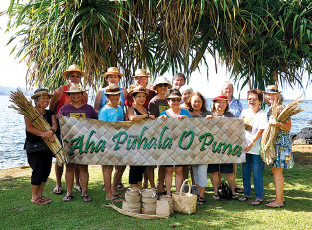
Members of ‘Aha Pūhala O Puna, who come mostly from the Hilo and Puna districts, regularly meet on the second Saturday of the month at Kea‘au Community Center, where they share weaving projects, discuss club activities and enjoy lunch and fellowship. Members can also volunteer with outreach efforts in their mission to teach lauhala.
“The club has taken upon itself a strong mission of outreach,” according to Katie, especially in the summer with the island’s three National Parks’ annual cultural festivals. They conduct free lauhala lessons for the visitors, beginning in June at Pu‘uhonua O Hōnaunau, in July at Volcanoes National Park and in August at Pu‘ukoholā Heiau in Kawaihae.
“We’re really busy doing outreach. We make up 500 kits for people to make lauhala bracelets that they get to take home with them. These are our three main volunteer efforts, and throughout the year we do others. When the National Parks pay us for the kits, it becomes a fundraiser for our conference.”
Katie sells hats and other lauhala items each year at the Merrie Monarch Invitational Hawaiian Arts Show, where she formerly shared a table with master Kona weaver Aunty Elizabeth Malu‘ihi Lee until she passed away last year. Now she and fellow club member Pam Lipscomb are carrying on that tradition, as well.
“I guess one of the most important aspects of lauhala for me has been the friendships that we all have with each other. I am so close with these other weavers, people I wouldn’t know without lauhala in our lives,” she says. ❖
‘Aha Pūhala O Puna 25th Anniversary Conference
“Nānā I Ke Kumu” (Look to the Source)
October 12–15, 2017 • Hilo Hawaiian Hotel, Hilo, Hawai‘i
Fee: $200 • Deadline to register: August 30
Email: ahapuhala@gmail.com / Phone: 808.756.0093
All photos courtesy of ‘Aha Pūhala O Puna
